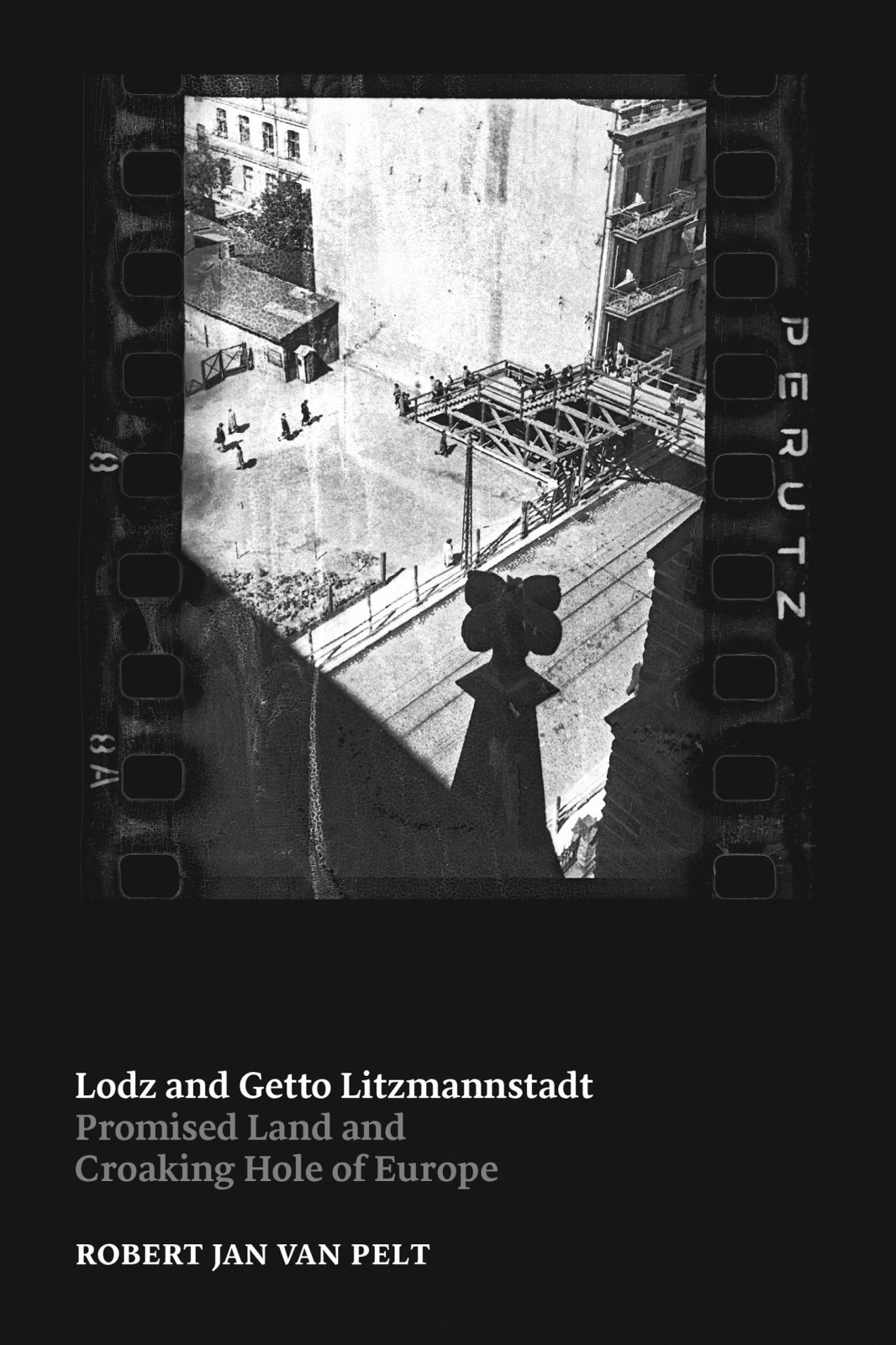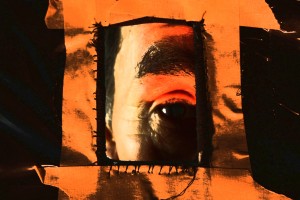On Monday March 2nd at 6:00pm, the BRIDGE Pop-up Storefront will host a book launch for three recently published books by professors from the University of Waterloo School of Architecture. Two books by Terri Meyer Book titled Diagrid Structures: Systems, Connections, Details, and Architecturally Exposed Structural Steel; along with Robert Jan van Pelt’s book Lodz and Getto Litzmannstadt: Promised Land and Croaking Hole of Europe, will be launched at the 60 Main street storefront. Please come by and join us.
The following is a description and excerpt from Robert Jan van Pelt’s upcoming book.
In September 1939 the Germans first occupied and then annexed to Germany the large Polish industrial city of Lodz, renaming it Litzmannstadt. In this city they established in April 1940 a closed ghetto for over 160,000 Jewish inhabitants in an area of four square kilometres. Its purpose was fourfold: hygienic, ethical, ethno-political and economic. As a hygienic measure, the ghetto, which was hermetically sealed from the outside world, should decrease the risk of epidemics in the rest of the city created by the concentration of so many people in such a small area. As an ethical measure, it should allow for the containment of the imagined moral, spiritual and physical threat emanating from Jewry. As an ethno-political measure, it was to provide a temporary holding pen for the Jews who were, at some future date, to be deported to the East. Finally, as an economic measure, the ghetto offered the possibility to strip Jews of whatever assets they still had. Very few of the Jews concentrated in the Litzmannstadt ghetto survived the war. Tens of thousands starved to death, and more than a hundred thousand were killed in the gas chambers of the Chelmno and Auschwitz death camps. The Polish-Jewish photographer Henry Ross recorded the lives, deaths, and deportations of the Litzmannstadt Jews. The Art Gallery of Ontario owns over 3,000 negatives of Ross’s photos, and ion January 31, 2015, it opened an exhibition of Ross’s work. Lodz and Getto Litzmannstadt: Promised Land and Croaking Hole of Europe was written to provide the historical context for Ross’s work.
Excerpt:
Prologue
This little book describes the history and destruction of the Jewish community of a city the Poles call “Łódź” (pronounced “woodzh”) and that those who speak other languages generally know and spell as “Lodz” (pronounced as “lawch”), a name its one-time German inhabitants spelled as “Lodsch” and its one-time Yiddish-speaking Jewish inhabitants spelled as “לאדזש.”
This little book tells a relentlessly depressing story of the systematic destruction of a vibrant community. Like any other community, it included many different people: young and elderly, smart and foolish, beautiful and ugly, successful and unsuccessful, resilient and weak, good and bad, hopeful and hopeless. Together they represented, in the microcosm of their community, the splendid plurality and variety of the human race. Together they embodied the countless possibilities that come with life in general, modern life in particular—with its ideals of liberty bound by law, fraternity amid competition, and equality from difference—and life in a great metropolis above all. Yet this multiplicity of different people became the object of a toxic, phantasmagoric and phantamorgasmic delusion that opposed the idea that the glory of humanity is to be found in its plenitude and plurality, and that defined the members of that community—young and elderly, smart and foolish, beautiful and ugly, and so on—as merely aspects of a single malign disease that ought to be rooted out from the earth. The champions of this radically evil sham set out to destroy this community, working hard to create conditions in which all of those different people were plunged to the lowest bottom, where life could persist only in a primordial equality that knows neither fraternity nor humanity—a life that then could be extinguished without a second thought as to whether all, or even any, deserved such a fate.
This little book tells a lopsided story about the destruction of a community. If it were to do justice to the nature, scale and scope of the catastrophe, it would devote hundreds of thousands of pages to record the hundreds of thousands of unique lives that were thus extinguished, and offer a single paragraph to the evil delusion that caused this tragedy. Knowledge of even one of those lives enriches our lives, while information about that monstrous libel does not. Yet as members of a community in which we are confronted daily with the pleasures and challenges that come with living amid a plurality of people, we do not really need to know all those biographies to know that each human being is created, as the Bible puts it, in the image and likeness of God, and that the murder of any one person equals, as the Jewish sages put it, the destruction of the world. This book assumes that you, the reader, remembers that each and every member of that community is not just a statistic, but remains an essential part of a plurality that encompasses not only the living—young and elderly, smart and foolish, beautiful and ugly, and so on—but also the dead, and the as yet unborn. It assumes, in other words, a basic understanding of the human condition. But it cannot assume knowledge of the concoction that, like a dream that evaporates in the morning, has no reality in the here and now, and does not belong to the life we share. Because it is an absurd figment of the imagination, because it has no roots in reality, it needs more attention than it really deserves. Such is the paradox of writing history.
This little book tells the story of a city where, until the fall of 1939, Poles, Germans and Jews rubbed shoulders—a city of occasional ethnic friction, but little ethnic collision. It was a remarkable city, quite unlike any other in Poland. “Ich bin in Lodz: Fabriken, Wildwest, Provinz” (“I’m in Lodz: factories, the Wild West, the sticks”), the German Jewish physician and author Alfred Döblin wrote in October 1924. Factories: rational determination; the Wild West: lawlessness; the sticks: narrow horizons. Many believe that Döblin caught in these three powerful and clashing images the essence of that most exasperating and also intriguing of cities—a city where, until the fall of 1939, Jews such as the poet Julian Tuwim (who wrote in Polish and not in Yiddish) felt at home: “Niech sobie Ganges, Sorrento, Krym / Pod niebo inni wynoszą, / A ja Łódź wolę! Jej brud i dym / Szczęściem mi są i rozkoszą” (“Let others debate the merits / Of the Ganges, Sorrento, or the Crimea. / Give me Lodz! Her dirt and smoke / Bring happiness and delight to me”). Then Nazi Germany attacked Poland, conquered the western part, incorporated Łódź/Lodz/Lodsch/לאדזש into the Greater German Reich, renamed it “Litzmannstadt,” imprisoned the Jews in a ghetto sealed from the world—a captive population and a town-size prison Henryk Rozencwajg-Ross (1910–1991) and Mendel Grossman (1913–1945) were to photograph over an almost four-year period. The Germans allowed a quarter of the inmates to die from starvation, turning the ghetto into what those who knew the conditions within its walls contemptuously referred to as the “Krepierwinkel Europas” (“croaking hole of Europe”), and killed the rest in Herbert Lange’s gas vans stationed at the village of Kulmhof, known by the Poles as Chełmno nad Nerem (1942–1944), and in the Auschwitz-Birkenau crematoria (1944).
“All books are divisible into two classes, the books of the hour, and the books of all time,” John Ruskin once wrote. This little book is unapologetically a book of the hour. It was written to provide context for an exhibition, at the Art Gallery of Ontario (AGO) in Toronto, of the mostly unauthorized photographs Ross made in the Lodz Ghetto—the negatives of which are in the AGO’s collection. Employed by the Statistics Department of the ghetto’s Judenrat (Jewish Council), Ross and his colleague Grossman were charged with making portraits of ghetto officials, documenting official meetings, producing passport-sized photographs of every ghetto inmate for identity cards, making a visual record of unidentified corpses abandoned in the ghetto streets, tracking physical changes in the ghetto as buildings were pulled down, and chronicling the efficiency of the ghetto workshops. While explicitly forbidden from the end of 1941 onward to make any personal or private photographs, both Ross and Grossman regularly ventured out in the ghetto to record ghetto life as lived, at risk of imprisonment and, during the great deportations, risk of life.
Prints of pictures Grossman took in the ghetto survive, but the 10,000 negatives Grossman, his sister Fajga Frajtag and his friend August Ben-Menachem buried in the ghetto before his deportation to a concentration camp in Germany were destroyed. Grossman did not survive the Holocaust, but Frajtag and Ben-Menachem did. Frajtag recovered the negatives in 1945 and sent them to Ben-Menachem, who had already moved to Palestine to join Kibbutz Nitzanim. During Israel’s War of Independence, the Egyptian Army captured and destroyed Nitzanim, and all the negatives were lost. Were they destroyed or taken as booty? There are speculations that they survive somewhere in Egypt.
The negatives of the unauthorized photos Ross made did survive. “In July 1944, when I heard and saw that the ghetto was about to be liquidated, that they were going to expel all of us, I hid the negatives in barrels and concealed them in the ground,” Ross told the Jerusalem Court sitting in judgment of former Gestapo official Adolf Eichmann in 1961. “Did you succeed in saving some of the negatives and bring them with you to Israel?” prosecutor Gideon Hausner asked Ross. “Yes,” Ross replied. “Some were destroyed owing to water seeping in, but the greater part was saved.”
Ross’s negatives have proved an enormous treasure. But not all of the photos were welcome. The images of people who were at the bottom end of the ghetto hierarchy because they were “useless mouths” as well as the images of people who provided the middle classes because they had the skills and strength to put in twelve-hour days in exchange for 800 calories were useful to the Jerusalem court and easily integrated into the Jewish collective memory of the Holocaust. But what to do with the images of the few who belonged to the ghetto elite, the members and families of the ghetto administration and the Ordnungsdienst (Order Service), the Jewish ghetto police? What to do with the visual evidence of these privileged Jews spending merry moments with colleagues, friends and family? This part of the Ross collection remained a no-go area until 2004, when British documentary photographer Martin Parr, photographer and curator Timothy Prus and historian Thomas Weber published a small selection of the more controversial images.
This little book provides a context in which to understand these photographs, which show that, within a situation designed to create complete equality in misery, some form of plurality remained—a plurality that was achieved at a price that might have included some form of collaboration, if not directly with the German rulers, than certainly with the German-imposed Jewish Council, headed by the notorious Mordechai Chaim Rumkowski. These images show a persistence of multiplicity in the second-largest ghetto created during the Nazi Holocaust of the Jews (1939–1945). One of the questions this book seeks to answer is how some measure of plurality managed to persist amid the grinding conditions imposed by the Germans.Where to begin? Perhaps a direction can be found by considering the subject of Ross’s photos: life in the Lodz Ghetto. What is a ghetto, or better, what was the ghetto in Nazi-ruled Europe? “The authorities of the Third Reich never actually defined the term ghetto,” historians Guy Miron and Shlomit Shulhani observe in the introduction to The Yad Vashem Encyclopedia of the Ghettos during the Holocaust (2009). “We have defined as a ghetto any part of a pre-existing settlement occupied by Nazi Germany where Jews were forcibly confined for at least a few weeks.” The adjective “pre-existing” is key: during the Holocaust, Germans and their allies also confined Jews to camps. Each of the many types of camps used to imprison Jews was without local precedent, unlike the German-imposed ghettos, which had clear relations to pre-war Jewish neighbourhoods,. The Nazi official who took the initiative to establish the Lodz Ghetto, Friedrich Uebelhoer, stressed the importance of precedent in a description of the creation of that ghetto: “We have taken the most effective but also the most radical action by expelling the Jews in Litzmannstadt to the district—namely the ghetto—from which they had poured over the city in earlier times,” he wrote in 1941.
In other words: the Lodz Ghetto was not a creation ex nihilo. It arose in a local context that included a historical ghetto from which the Jews had emerged “in earlier times” and to which they were returned under German rule. This suggests that any understanding of the history of the Lodz Ghetto must reach back to the time of that original settlement of Jews in Lodz, which coincides with the beginning of the industrial development of the city as a centre of textile production.
In addition, the expulsion of the Jews to their place of origin happened in a larger ideological context. The German propaganda pictures that illustrated Uebelhoer’s text were captioned by a single sentence that concisely summarized the Nazi Weltanschauung (world view) concerning the Jews, and hence the ideological foundation of the Holocaust: “The vital nerve of International Jewry has been hit in Litzmannstadt.” The idea that Jews in Lodz had been brought back to a point of origin and the idea that the internment of the Jews in that city would radically weaken “International Jewry”—whatever that might be—seemed vitally important to Uebelhoer. It appears we may gain some understanding of the purpose of the ghetto not only by considering the pre-1939 history of Lodz in some detail, with a special focus on where Jews lived and the relative size of the Jewish community in relation to other communities, but also by gaining an understanding of the Nazi Weltanschauung in which “International Jewry” could be choked by imprisoning the Lodz Jews.
This little book does not tell a happy tale. But it is an important one, and perhaps even an urgent one, as it is told in a time in which the old phantasmagoria that created the Nazi Holocaust of the Jews seems to have gained new life—and not only in the Middle East, but also in Europe and, to a lesser extent, North America. This is indeed, and sadly, a book of the hour






Leave a Reply